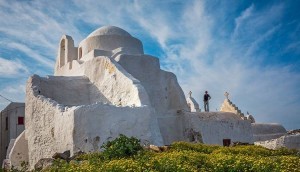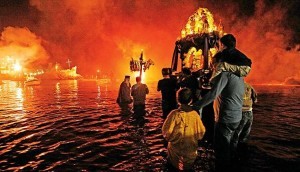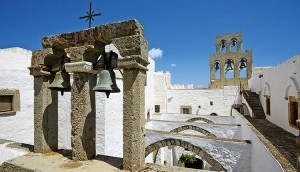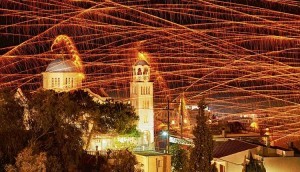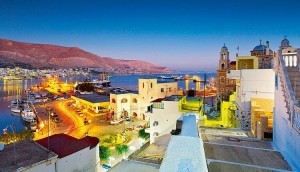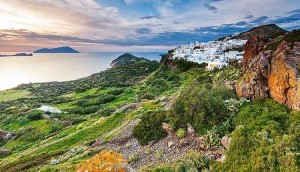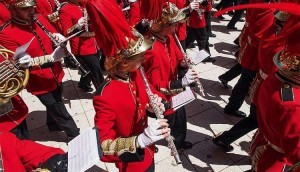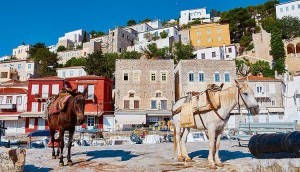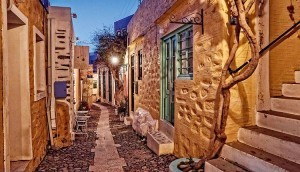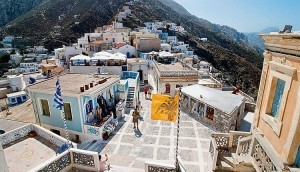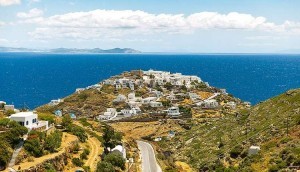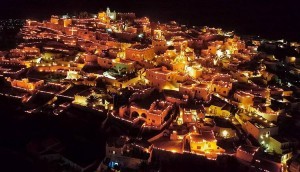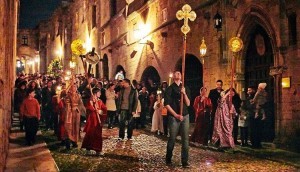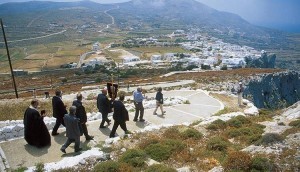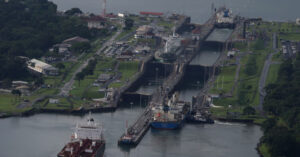Across Greece, Easter is the most important holiday of the year, but every island has its own quirks, local traditions and unique selling points for visitors.
1. Mykonos – Party like a local
What makes it Special
Easter is an opportunity to see a different side of this famous and cosmopolitan island. The hills are covered in green and wildflowers as the island awakes from its winter slumber and once begins to attract visitors looking to revel in its unique energy. As always, the island’s love of a great party is fully on display, but over Easter more traditional and intimate affairs replace the thumping parties of the summer months.
Local Easter Events and Traditions
On Good Friday the place to see the Epitaphios processions is outside the folk museum Lena’s House where women from the local Folklore Association offer homemade treats. During the processions, the cafe-bars turn down the music or switch it off entirely, but once they have ended the volume comes back up and bar-goers stay out enjoying themseleves until the early hours.
On Holy Saturday you can continue enjoying eating, drinking and dancing, or take a break to see the Anastasi at the pretty Monastery of Panaghia Tourliani in Ano Mera.
On Easter Sunday if you want to enjoy the best food the island has to offer, a reservation is a must in one of the island’s top restaurants such as M-eating (+30 22890-78550) or the meze restaurant Captain’s – Food for Sharing (+30 22890-23283). Alternatively just let yourself be carried along by the mood of the moment.
2. Tinos – Where Orthodoxy meets Catholicism
What Sets it Apart
Thanks to a period of Venetian rule, this beautiful Cycladic island, located only a few short hours from Athens, has both Catholic and Greek Orthodox churches, which celebrate Easter side-by-side, making for a unique experience. With a long and proud history in marble crafts, the island also features some of the most unique villages in the Cyclades. This tradition has also led to the creation of a burgeoning contemporary art scene, with a particular emphasis on sculpture.
Local Easter Events and Traditions
On Good Friday the Epitaphios processions from seven churches converge on the Chora waterfront. From there the Epitaphios from the church of Aghios Nikolaos (the patron saint of sailors) heads toward the beach where it is taken into the water to bless the island’s sailors. At the same time three large crosses are set alight, while fishing boats honor the procession with flares in a moving spectacle.
At midnight on Holy Saturday, for a rousing (and deafening) celebration of Anastasi, with large crowds and extensive use of firecrackers, head to the Church of Panaghia Evangelistria in the main town, the most important church on the island. If you prefer a more intimate and low-key affair, opt for a church or monastery in one of the villages.
On Easter Sunday the tradition here is to cook lamb or goat in the oven, although some tavernas also prepare it spit-roasted. If you head to Pyrgos you will also witness the tradition of the trimbonia – specially constructed devices / weapons which are fired during the liturgies to ward off evil.
3. Patmos – The island of the relevation
What Sets it Apart
This island in the Dodecanese has a particular significance for the Christian world given that it was here that St John penned the Book of Revelations. Today the wonderful Chora of the island is crowned by the Monastery of St John the Theologian, built only a short distance away from the Cave of the Apocalypse where St John is said to have been visited by the Holy Spirit.
Local Easter Events and Traditions
On Holy Thursday at 11.00 in the morning in Chora you can witness the reenactment of the Last Supper when the abbot of the Monastery of St John washes the feet of 12 clerics who play the role of the disciples.
Then on Good Friday you can observe a reenactment of the Descent from the Cross at the Monastery of St John and in the evening head down to the main square of Skala where a number of Epitaphios processions meet. In the Chora, a number of Epitaphios processions meet in the small square of Aghia Lesvia.
On Holy Saturday celebrate Anastasi in the Monastery of St John the Theologian. For a quieter affair opt for the women’s monastery of Zoodochou Pigis in Chora.
On Easter Sunday you can enjoy the traditional lamb on a spit together with local delicacies at the island’s tavernas. For the spiritually minded, head once again to the Monastery of St John for the Easter Sunday Vespers during which the Gospel according to John is read in seven languages, in order to proclaim the good news of the resurrection to all.
4. Chios – The island of the rocket wars
What Sets it Apart
This large, cultured and fertile island in the Dodecanese is famed – aside from for its mastic (the aromatic resin produced from the lentisk tree) and exceptional citrus fruit – for the ‘rocket wars’ that play out on Holy Saturday between two hillside parishes and make for a truly awesome spectacle.
Local Easter Events and Traditions
The most impressive Epitaphios procession takes place in Nea Moni of Chios, a beautiful 11th-century monastery and UNESCO World Heritage Site. On the morning of Good Friday you can also follow the Epitaphios through the abandoned village of Kydianta, where the procession is led by the village’s former residents without a priest.
On the night of Holy Saturday the parishes of Aghios Markos and Panaghia Ereithiani in Vrontados fire their first ‘warning shots’ at each other over the valley that separates them from about 21.00. But it is only after the priest announces that ‘Christ is risen’ at midnight that hundreds of homemade rockets are fired from one church to the other in a ‘battle’ that sees the sky fill with streaks of flame. The locals say that the best places to view the spectacle is from the Aghios Makarios monastery, or from various points on Mount Aipos.
A fantastic Anastasi can also be had at the village of Mesta where an effigy of Judas is burned, and fireworks boom and crackle during a night-long festival of eating, drinking and dancing.
5. Kalymnos – Where the earth shakes
What sets it apart
The people of Kalymnos like things that go boom. A lot. At Easter this large island in the Dodecanese has a tradition of going beyond the conventional bangers and setting off actual dynamite on the hillsides. Its not for the faint of heart. Beyond that the island is also famed for its world-class rock climbing, and spring is the ideal season to do it.
Local Easter Events and Traditions
In the sizable main town of Kalymnos (Pothia) the entire population fills the streets on the evening of Good Friday. Ten Epitaphios processions (plus another three from the neighboring settlement of Chorio) move along the coastal road which is packed with people, and an informal competition as to which church has the most impressive funerary bier takes place.
In the morning of Holy Saturday locals begin preparing the island’s traditional Easter dish known as mououri. It consists of lamb or goat stuffed with rice, liver and tomatoes, cooked in a clay dish. This is placed in a wood-fired oven which is sealed with mud and stones and only opened the next day. But the groups that prepare the ovens will have already started the merrymaking.
At 12.00 in the afternoon the first Anastasi takes place, during which Judas effigies are burnt and the first sticks of dynamite are set off in the the main square, created a din together with the tolling of the church bells that rocks the whole island. The Anastasi at midnight is a slightly quieter affair, after which groups gather for the traditional hearty soups: ‘hoof and head’ soup, patsas or mageiritsa.
On Easter Sunday the main event to enjoy is the traditional feast in the main square of Kalymnos Town. Local musicians and dance groups perform; here you will also see the Kalymnian ‘Mihanikos’ – a dance that represents the debilitating effects of decompression sickness that were experienced in the past by the island’s sponge divers.
But at 17.00 steel yourself as this is when the true shock-and-awe spectacle begins. 20-30 people climb to the top of the cliffs over Pothia and set off dynamite into the evening, after which more conventional fireworks follow.
6. Milos – A loud and fiery spring
What sets it apart
As with all of the Cycladic islands, at this time of year Milos is covered in a carpet of green and wildflowers. Here all of the villages also observe the rite of the Burning of Judas, with bonfires scattered across the island. And in the village of Triovasalos, things get even more explosive. While on the island it also worth renting or hiring a boat to take you around its renowned beaches.
Local Easter Events and Traditions
If traveling with kids, on the evening of Good Friday be sure to take them to the port of Adamanta where locals release sky lanterns carrying wishes. On the evening of Holy Saturday, services being at 23.00 and when the cry of ‘Christ is risen rings out’, the first of the impressive fireworks at Triovasalos are set off.
On Easter Sunday the Burning of Judas at most villages takes place in the afternoon. However in the villages of Triovasalos and Pera Triovasalos, the burning takes place at 12, after which there is a ‘firework battle’ – a tradition with deep roots.
On Easter Monday it is also worth visiting the famed Catacombs of Milos, where at 19.30 hymns are sung.
7. Corfu – Ionian Melodies
What Makes it Special
Corfu’s long and rich tradition in music and its philharmonic orchestras create a unique atmosphere in the island’s cultured capital. For a longer stay this large and cultured island also has plenty to offer the springtime visitor.
Local Easter Events and Traditions
Grab a place from early on along the route taken by the Epitaphios procession from the Metropolitan Church of Corfu, followed by local dignitaries, three philharmonic orchestras and throngs of people (the best places are along the stretch from Mouragia to the Liston Square). From around 10pm you will hear each of the orchestras playing different classical funeral marches.
On the morning of Holy Saturday, don’t miss Corfu Town’s famed Botides tradition, when large clay pots are cast out of windows and smash on the ground after the first Anastasi. In the evening head to the church of Aghia Paraskevi in the city. Shortly before midnight a procession sets off from here consisting of philharmonic orchestras together with Orthodox and Catholic choirs. They head to Spiniada Square where the Anastasi service is held.
On Easter Sunday most tavernas and households eschew spit-roasting lamb, instead cooking it in clay pots. Head to Palia Peritheia with its Venetian architecture, rich history and delicious food at its traditional tavernas.
8. Hydra – Artist’s paradise
What makes it special
The homeland of many old ship-owning families, this cultured island features wonderful historic mansions lining small streets on which cars are forbidden. The late Leonard Cohen’s longtime adopted island, Hydra continues to be a hub for artists, and to enchant all comers with its air of taste and sophistication.
Local Easter Events and Traditions
For something out of the ordinary, on Good Friday head to Aghios Ioannis Prodromos where a local tradition is observed linked to the island’s seafaring tradition. Young men carry the Epitaphios into the sea until they are waist deep so that the waters may be blessed and calmed.
On the evening of Holy Saturday, watch as the Holy Fire arrives by sea to the port, after which the Anastasi service is held at the nearby Koimiseos tis Theotoikou church. Boats and ships herald Christ’s resurrection with flares and sirens.
In the afternoon of Easter Sunday, head to the port again where the Burning of Judas is carried out. Young men in traditional costumes carrying muskets set the effigy alight and the bonfire is accompanied by fireworks.
9. Spetses – History & class
What Sets it Apart
Like Hydra, Spetses is a small island with a great nautical history, evident in the grand old sea captain’s houses in the main town. They, together with landmarks such as the historic Poseidonio Hotel lend an aristocratic air to this small, green island only a taxi-boat ride away from Porto Heli in the Peloponnese.
Local Easter Events and Traditions
On Good Friday head to the square in front of the Poseidonio hotel near the main port where the Epitaphios processions from four churches converge.
For Anastasi on Holy Saturday, if it is a quiet and reverent atmosphere you are looking for without firecrackers, head to the Monastery of Aghion Panton outside of the main town on the hill located above the bay of Aghia Marina. Alternatively go to the church of Analipsi where, as soon as the bells begin to toll at midnight, the locals set fire to a wooden boat in the courtyard of the church.
On Easter Sunday, along with the traditional roasting of lamb, in the square of Kounoupitsa an effigy of Judas is burnt.
10. Syros – Cycladic capital
What Sets it Apart
In Ermoupoli, the cultured town that is the capital of the Cyclades, Catholics and Orthodox Christians celebrate Easter side-by-side, in a show of unity and mutual respect.
Local Easter Events and Traditions
On Good Friday, head to the Monastery of Aghia Varvara near Kini. Here the Epitaphios emerges much earlier – at about 17.00 – and the procession moves along paths through the countryside. If you want to take in the rite in town, head to the main square in front of the grand town hall where all of the Orthodox Epitaphios processions converge.
On the evening of Holy Saturday head up the hill to the church of Anastasis tou Christou from where you will have a fantastic view of Ermoupoli and the fireworks. Alternatively, if its a Catholic church you prefer (again with a view of Ermoupoli) visit Aghios Georgios in Ano Syros.
On Easter Sunday the Burning of Judas is observed at the Church of the Koimiseos tis Theotokou following Agape Vespers (a special evening service where the Gospel is read in as many languages as possible).
11. Olympos village, Karpathos – Go back in time
What Sets it Apart
Located at the wildest end of one of Greece’s remotest islands in the southeastern Aegean, Olympos on Karpathos is not easy to get to (traveling by ferry can take upwards of 20 hours, although the island does have an airport). That said, the experiences this ruggedly beautiful island offers are truly one of a kind. Immerse yourself in its atmosphere, try local dishes and experience a different kind of Greek Easter.
Local Easter Events and Traditions
On Good Friday, during the day the church of Koimiseos tis Theotokou is the site of a truly moving tradition: women of the village dressed all in black decorate the Epitaphios funeral bier with flowers, and also pin to it photographs of friends and family members who died in the past year, together with dedications. The women then let down their hair and begin mourning Christ as well as their deceased loved ones. At night, the Epitaphios is taken to all of the homes in the village, stopping at those who have lost loved ones, where the names of the deceased are read out.
On Holy Saturday the village of Olympos fills with the scent of ofto – goat or lamb stuffed with rice and cooked for a day and a night in wood-fired ovens, to be consumed on Easter Sunday. In the evening, for the Anastasi service, many of the women wear traditional dress.
On Easter Sunday be sure to try some of the slow-cooked ofto at one of the village’s tavernas. In the afternoon all of the residents and visitors gather in Plati for traditional singing and dancing.
12. Naxos – The island that has it all
What Sets it Apart
As the largest and most fertile island in the Cyclades, Naxos has everything from seaside churches to mountain villages, each with their own traditions and customs. And with plenty of local products, the food is some of the best you’ll find anywhere.
Local Easter Events and Traditions
On the morning of Good Friday in the church of Panaghia Drosiani in the village of Moni special Easter breads are baked with aniseed, raisins, almonds and walnuts. Fresh out of the wood-fired oven they are handed out together with raki after the church service.
Later in the evening the Epitaphios processions are special wherever you are on the island. In Chora, three Epitaphios processions meet in Aghia Theodosia, while in the village Kastraki the Epitaphios is taken along the waterfront and then into the sea. In the villages Galini and Eggares, young men hold flaming torches made from reeds to light the way for the procession along the dark alleys.
On Holy Saturday, the most popular place to celebrate Anastasi is the Metropolitan Church in Chora. For a more low-key and spiritual affair ideal for families with small children, head to the village Damalas. Here the church is not connected to the electrical grid meaning everything is done by candle-light, and there are no loud firecrackers. The service is also held earlier (Anastasi takes place at 21.30-22.00 instead of midnight) so that the priest can then head to other parishes.
On Easter Sunday the thing to eat is batoudo: goat stuffed with rice, chard, fennel, wild greens and offal, although beyond that you will find tables laden with a host of other traditional goodies.
13. Sifnos – A gastronomic journey
What Sets it Apart
While you’ll eat well (and a lot) wherever you go in Greece at Easter, on Sifnos traditional Greek cooking meets an added level of refinement. The diligence and attention to detail shown here in preparing food is something that the island prides itself on; it’s an ethos that has been passed down from generation to generation. Beyond the festivities and food this is also the perfect time to discover Sifnos’ network of well-maintained hiking trails.
Local Easter Events and Traditions
If you pop your head into a church on Good Friday you will likely see young women helping decorate the Epitaphios funeral biers. In the evening processions from different parishes converge on the churches of Panaghia Gournia, Panaghia of Ammos and Aghios Stylianos in Arades.
The ‘official’ Anastasi with the most people takes place in the metropolitan church of Aghios Spyridonas in Apollonia. That said, from the church of Aghios Ioannis in Petali, built on a mountainside, you will see the fireworks from three or four other parishes.
The next day all of the parishes celebrate the second Anastasi or Agape Vespers at 11.00 in the morning at the Monastery of Vrysi in Exambela. Afterwards the star of the lunchtime table is mastelo: goat slow-cooked in a clay pot, with the meat resting on cuttings from grape vines. Afterwards traditional dancing with live music adds to the merriment.
14. Santorini – The most magical good Friday
What Sets it Apart
At Easter, Greece’s most famous island is host to a spectacle that befits the grandeur of its caldera: the clifftop villages are transformed into magical labyrinths with thousands of lanterns lighting the narrow streets. This is also a perfect time to take in this remarkable island free from the throngs of summer tourists.
Local Easter Events and Traditions
Good Friday in the village of Pyrgos is not to be missed as lanterns fill almost every corner, creating an otherworldly scene and lighting the way for the Epitaphios procession. In recent years this custom has also spread to the villages of Oia, Kontohori and Firostefani. Earlier in the day visit Emporeio where local groups wander through the village playing traditional bagpipes and ringing bells in order to call out the residents for the Epitaphios.
During Anastasi, balafloumades – a type of improvised firework – herald the resurrection of Christ in all of the island’s villages. If you prefer a quieter experience head up to the Monastery of Profitis Ilias, built on the island’s highest point, where fireworks are forbidden. From there you will have the entire island laid out at your feet, with the villages lit up by the flashes of fireworks.
On Easter Sunday, together with the traditional roasting of lamb, in the village of Perissos, the Burning of Judas is also observed.
15. Rhodes old town – Easter in a medieval setting
What Sets it Apart
For a unique Easter, there are few more remarkable settings than the Old Town of Rhodes, where the medieval setting makes one feel that the days of the knights never really ended.
Local Easter Events and Traditions
Choose one of the churches in the Old Town of Rhodes and feel the mystical atmosphere during the Epitaphios procession through the narrow streets and along the city walls. Particularly popular among the faithful is the always impressively-decorated Epitaphios of the church of Agios Taxarchis in the municipal cemetery.
The next day, head to the church of Aghios Nikolaos in the village of Pastida, 11km from the town. The first Anastasi is celebrated in a deafening manner, with the faithful banging the wooden pews. Later at night after the ‘Christos Anesti’ (Christ is risen) is sung, an effigy of Judas is burnt in front of the church. For an Anastasi by the sea, opt for the church of Evangelismos next to the port.
On Easter Sunday, the village of Aghios Isidoros maintains the tradition of the Vournes. From Holy Saturday the unwed youth of the village must light and maintain a large bonfire until Easter Sunday for the Burning of Judas. Afterwards they are ‘judged’ based on their participation, and those found wanting are thrown into ditches filled with water.
16. Folegandros – Clean and simple
What Sets it Apart
This archetypal ‘small Cycladic island’ with its charming Chora, has an intimate and welcoming atmosphere. With no cars in the main village, it is perfect for families and carefree holidays, where you immediately start to feel part of one big, extended family.
Local Easter Events and Traditions
There isn’t a huge range of options in terms of Good Friday Epitaphios processions, but that is part of the appeal. Head to the central church of Aghios Nikolas in the Chora and then follow the Epitaphios around the charming alleys of the village with the locals and visitors.
The next evening when the first ‘Christos Anesti’ rings out, at the same church the night will turn to day with plenty of fireworks.
The island’s most singular custom takes place on Easter Sunday and lasts until the following Tuesday. From the iconic church of Panaghia built above the Chora, the icon of the Virgin Mary is carried out and taken all around the island. Crowds of people follow and are offered food and drink at almost every home along the way. The icon is taken by foot from the Chora to the church of Aghios Georgios in Ano Meria where it is kept for the night.
The next day it is taken around the village of Ano Meria, again with many people following and plenty of food and drink and firecrackers. Then on Tuesday the icon is taken by foot to Petousi and Livadi and with the procession ending in the seaside settlement of Karavostasis to bless the homes there. If the weather permits, the icon is then taken onto a boat and sailed around nearby bays, before being returned to the church of Panaghia.
Source: thegreekobserver
Ask me anything
Explore related questions

